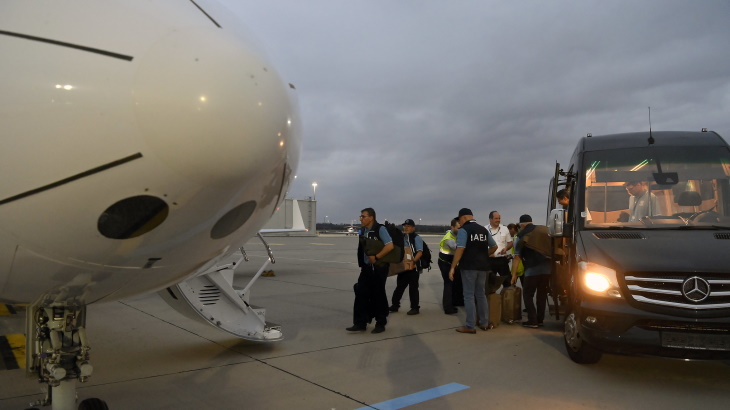Following months of negotiations, a team of International Atomic Energy Agency (IAEA) experts and inspectors - led by IAEA Director General Rafael Mariano Grossi - is on its way to the Zaporizhzhia nuclear power plant in Ukraine to ensure nuclear safety and security there.

The mission team board their flight to Kyiv at Vienna International Airport (Image: Dean Calma/IAEA)
Grossi and the team set off from the IAEA's headquarters in Vienna in the morning of 29 August for the IAEA Support and Assistance Mission to Zaporizhzhia (ISAMZ).
Interfax reported that the team had arrived Kyiv. "Yes, the IAEA mission is already in Kyiv," Ukrainian media quoted the Energy Ministry's press service as saying on Tuesday 30 August. However, the mission's further plans have not yet been made public "for security reasons".
The IAEA said the team is expected to reach the Zaporizhzhia plant later this week.
Once it has reached the plant, the ISAMZ team will assess the physical damage to the facilities, determine the functionality of the main and backup safety and security systems, and evaluate the working conditions of the control room staff. At the same time, the mission will undertake urgent safeguards activities to verify that nuclear material is used only for peaceful purposes.
The IAEA said the mission "will bring clarity to the situation and help address any contradictory information about the status of the facility, its operation and the damage it has sustained".
The Zaporizhzhia plant has been under Russian military control since early March, but continues to be operated by its Ukrainian staff. It is the first time a nuclear power plant has been occupied by a military force. There has been continued military action in and around it, with both sides blaming the other for the intensified shelling over the past few weeks.
Earlier this month, Grossi said: "In this highly volatile and fragile situation, it is of vital importance that no new action is taken that could further endanger the safety and security of one of the world's largest nuclear power plants. There is an urgent need to lower the tension and take the necessary steps to help ensure nuclear safety and security and prevent any radiological consequences for the population and the environment. The IAEA can play an indispensable role in this regard."
This month the site has come under repeated shelling, and last week temporarily lost connection to its last remaining operational 750 kilovolt external power line. Energoatom said the PL-750 kV Dniprovska overhead line was disconnected at least twice on 25 August. As a result, the plant's two operating reactors - units 5 and 6 - were disconnected from the grid.
Both units are operating again after being re-connected to the grid on 26 August. The other four units at the plant have remained in shutdown.
Ukraine informed the IAEA that the site had since come under renewed shelling but that all safety systems remain operational and there had been no increase in radiation levels.
Researched and written by World Nuclear News